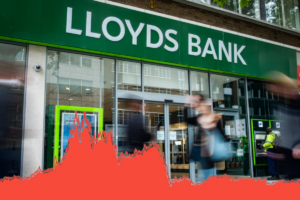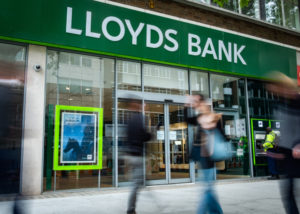Lloyds Banking Group Plc (LLOY) current share price is 49.7p (as of 16/04/2024 16:37) which is a change of -1.46 or -2.85% from the last closing price of 49.7. But what is next for the Lloyds share price? Our Lloyds share price analysis and market data includes key financials, earnings estimates, peer performance, dividends, news and company profile.
Is Lloyds a Buy, Sell or Hold?
Unlock Our Actionable Investing Insights To Be A Better Investor
Become a better, more informed investor with Good Money Guide. Our expert exclusive analysis provides the sort of information that everyone, from first-time investors to experienced professional traders, can learn to profit from.
- Expert analysis on stocks, indices, commodities & currencies
- Major market moves explained
- Pros & cons of specific investments
- Buy or sell ratings & reviews
- Free ticket to the London Investor Show
Can Lloyds reach £1 in the next five years?
Lloyds Share Price Analysis

Will Lloyds Shares Reach £1?
Lloyds (LLOY:LON) shares have struggled to generate any real momentum in recent years. Currently, they are trading for around 42p, roughly 25% below the level they were trading at five years ago. Will Lloyds shares ever hit £1 again? Possibly. However, for Lloyds’ share price to rise to the one pound level, a number of

Why is the Lloyds price so low?
For many, buying one of UK largest banks – Lloyds Banking Group (LON:LLOY) – was a seemingly safe option. Should any credit crisis emerge, surely the government would come riding to its rescue. But apart from that, what’s the rationale for sticking with Lloyds shares? At 45p, Lloyds’ share price is not much higher than

How low can the Lloyds share price go?
Lloyds’ (LON: LLOY) shares have underperformed in recent years. Today, the shares are changing hands for just 42p – around 27% below the level they were trading at five years ago. At this stage, many investors are probably wondering just how low the Lloyds share price can go. So, let’s examine the outlook for the stock.

Will the Lloyds share price recover above 50p?
Lloyds Banking Group (LLOY) is one of the largest banks in the country. It has 26 million active customers, and post-tax profits last year exceeded £5.5 billion. By most metrics, Lloyds is among the most profitable companies in LSE. In this analysis, I give my thoughts on why the Lloyds share price going down and

What will Lloyds share price be in 5 years?
In this analysis, we take a look at where the Lloyd’s share price may be in five years’ time. We look at how Lloyds has performed historically in times of high interest rates, how they are profitable in a challenging market and whether Lloyds shares should be included in your long-term portfolio. How did Lloyds

How To Buy Lloyds Shares (LON:LLOY)
To buy shares in Lloyds (LON:LLOY), you need a trading or share dealing account. Follow these three steps if you want to buy shares in Lloyds Bank: Open an investment account with a stock broker Deposit funds from your bank account or debit card Search for the symbol “LLOY” on the investment platform Enter the

What is the next Lloyds dividend?
Lloyds shares are popular with income investors. This is due to the fact that the bank currently offers an attractive dividend yield. Looking for details on the next Lloyds dividend? Here is everything you need to know. Is Lloyds paying a dividend in 2023? Lloyds rewarded shareholders with an attractive dividend in 2022 and it

Will Lloyds Bank pay a dividend in 2023?
Dividends are cash payments that some companies pay to their shareholders. These payments are essentially a reward for being a part-owner of the business. Will Lloyds Bank pay a dividend in the years ahead? Let’s take a look. 2023 Lloyds Dividends At present, the 2023 dividend forecast for Lloyds shares is 2.8p per share. This

Lloyds rewards shareholders with £2bn buyback after robust results
Lloyds bank sailed through the turbulent economy delivering a pre-tax profit of £6.9 billion for 2022. Flushed with profits, Lloyds is set to reward shareholders with a multi-billion share buyback. While the market is continuing to be rocked by macro concerns, should you buy Lloyds shares? Is Lloyds (LON:LLOY) a good investment in the long…
Lloyds Banking Group Plc Share Price (LLOY) Quote & Overview
This section shows the most important aspects of the current Lloyds Banking Group Plc LLOY:LN share price including price, change, bid/offer spread and volume.
Lloyds Banking Group Plc (LLOY) Company Financials
This section shows current and previous Lloyds Banking Group Plc LLOY:LN profit and loss information like revenue, income, expenses and earnings per share.
Lloyds Banking Group Plc (LLOY) Earnings Estimates & Forecasts
This section shows how analysts expect the Lloyds Banking Group Plc LLOY:LN share price to perform in the future based on their earnings reports and estimates. It gives an overview of future short, long and medium term price targets as well as previous earnings reports.
Lloyds Banking Group Plc (LLOY) Financial Summary
This section allows you to compare Lloyds Banking Group Plc LLOY:LN revenue, net income, cash flow statement and balance sheet against previous years. This can give you a good indication of how well a company is performing.
Lloyds Banking Group Plc (LLOY) Share Price History
This section provides a visual and table view of the historic Lloyds Banking Group Plc LLOY:LN share price including volume and VWAP which can be adjusted for splits and dividends.
Lloyds Banking Group Plc (LLOY) Interactive Chart
This section allows you to compare Lloyds Banking Group Plc LLOY:LN share price chart against other stocks as well as overlay key events like dividends, earnings and splits.
Lloyds Banking Group Plc (LLOY) Dividends
This section analyses the historic and upcoming Lloyds Banking Group Plc LLOY:LN dividend amounts, dates and yields. It provides a good indication of potential future and past profitability.
Lloyds Banking Group Plc (LLOY) Corporate Events
This section shows key dates in Lloyds Banking Group Plc LLOY:LN corporate calendar like company announcements, earnings releases, stock splits, and fundamental data chances like EPS updates.
Lloyds Banking Group Plc (LLOY) Share Price Performance
This section shows key Lloyds Banking Group Plc LLOY:LN share price levels like recent highs and lows, plus gives you tools to see average day traded volumes and institutional share holders major buys and sells.
Lloyds Banking Group Plc (LLOY) Share Price News
This section shows new stories that are relevant to and may effect or explain changes in Lloyds Banking Group Plc LLOY:LN share price.
Lloyds Banking Group Plc (LLOY) Company Profile
This section provides corporate information on Lloyds Banking Group Plc LLOY:LN, including what they do, their contact details, their CEO and auditor as well as in what sectors their shares trade.
Lloyds Share Price FAQs
We have taken a look at where the Llloyds share price may go. To find out what the Lloyds share price will be in 5 years read our expert analysis on the the future of LLOY shares: What will Lloyds share price be in 5 years?
The current Lloyds bank share share price is 49.7p (as of 16/04/2024 16:37) which is a change of -1.46 or -2.85% from the last closing price of 49.7.
Lloyds share price in the UK has most likey dropped today because of negative sentiment or negative corporate earnings. The current Lloyds EPS (earnings per share) are 0.08 and the PE (price earnings ratio) is 6.62.
- Further reading: Will the Lloyds share price recover above 50p?
There are a few reasons the Lloyd banking group share price is so low and stagnating. The first is the general downbeat sentiment on UK equities. Political uncertainty, poor UK productivity, and a lack of tech stocks are making the LSE a dull place. Also, don’t forget that the UK is due another General Election in 2024.
- Read our full analysis: Why is the Lloyds price so low?
The Lloyds share price is because of macro UK economic activity – which has been weak recently – picks up from lately. The share price Lloyds level investors should be worried about has not been hit yet but for more information read our expert analysis: How low can the Lloyds share price go?
